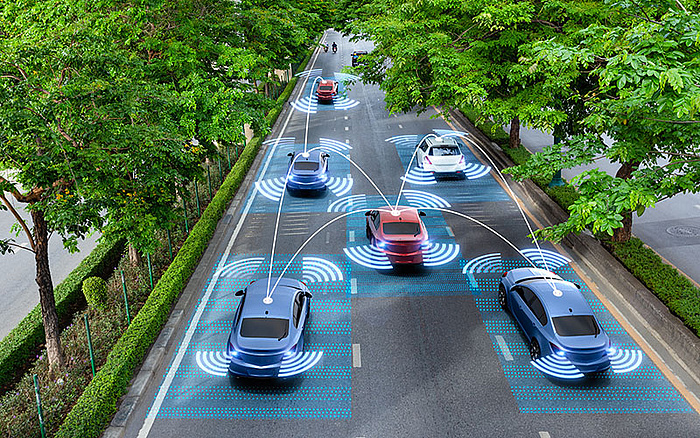
And yet they move: a story of IP and technology assessment
In a world where autonomous delivery vehicles ply the roads on their own, it is Intellectual Property (IP) that is truly in the driving seat. This new era of transportation technology needs an approach to IP management that is as dependable, protective and energized as the robotic couriers sharing our city streets.
Creating a fleet of autonomous vehicles that can match or exceed the average driver for safety and reliability is no small feat. Consider that the human brain has some 100 billion neurons, each able to connect to around 1,000 others, making for 100 trillion synapses. The spontaneous actions and reactions we take for granted are extraordinarily difficult to emulate digitally, and no automobile yet possesses an instinct for self-preservation nor innate consideration for the welfare of other road users.
Putting the "auto" in automobile
Until artificial intelligence (AI) inherits the better angels of our nature, a plethora of advanced instruments, processors and programming must fill in for millions of years of biological evolution. By way of proximity sensors, cameras, lidar (light detection and ranging) and radar, a new generation of vehicles is able to perceive its surroundings. Not limited by a single observation point behind a windshield, such vehicles have an unobstructed view to read traffic signs, detect obstacles and follow roadways. Finally, thanks to today's cutting-edge AI models, self-driving cars can anticipate potentially dangerous situations.
All of these systems and technologies must work together flawlessly if autonomous vehicles are to convince governments and the general public of their merits. This is a monumental challenge for any company to take on, but there are those bold enough and possessing of the right talent to rise to the occasion. Nevertheless, orchestrating so many high-demand R&D projects at once requires an IP function that operates at peak performance.
A roadmap for innovation
In this exciting environment, it is critical for manufacturers to offer safe, roadworthy and economically viable vehicles that optimize customer benefits. At the same time, developers need to make their technological progress efficient and effective. This entails identifying and remedying weaknesses in one's own solutions early on, circumventing third-party exclusive rights and shrewdly using the strengths of one's patents and trademarks.

Many technologies developed for autonomous vehicles could be implemented into "smart" cars to improve driver awareness and safety. For one, wirelessly connected automobiles would be able to communicate with one another, relaying information about potential dangers further down the road.
Against this background, one of the leading producers of autonomous vehicles asked Dennemeyer Consulting for support in streamlining its IP creation. Even before starting this project, the business found itself at the forefront of a new paradigm: It was and is one of the few companies in the United States currently allowed to deploy fully driverless cars on public roads, with approval to operate in at least two urban areas.
Of course, no company has it all. Resource pressures meant product development and IP creation needed to be aligned with the overall corporate strategy. In parallel, a thorough patent-based technology assessment was desired to identify growth potentials and minimize risks.
The navigator at your side
Dennemeyer's consultants contributed their experience in IP analytics by crafting an individualized approach that assessed the relevant technology fields and delved into the company's main differentiating features. A patent-based technology analysis allowed the company to gain deeper insights into its progress by answering two key questions.
"What are the opportunities for developing new solutions that strengthen our unique technology profile?"
The first question aimed to uncover general and untapped prospects in the relevant field of knowledge. Based on this outline, company experts then identified, detailed and weighted technology sub-areas and characteristics. Once this was completed, the results were used to design a customized method of patent analysis that accounted for internal priorities and achievable targets.

When surveying the patent landscape surrounding your business, it can be difficult to apply an unbiased measure of what is valuable and what is not. An outside, informed perspective can be just what is needed to gauge the situation accurately and provide you with the best insights.
"Who are the competitors and new players that the company should keep an eye on?"
The second question addressed the market landscape. This analysis reviewed the established players, what technologies they focus on and which up-and-comers would need to be monitored closely. These findings later fed into a consideration of the steps necessary to maintain and expand the company's advantage.
No shortcuts to sustainable growth
Guiding the policy decisions of a research-heavy business by means of IP analytics is an intricate, deeply layered undertaking that demands great care. Hence, an ongoing process of reflecting on interim results was set up. The point was refinement rather than redundancy – take the requested patent survey as an example.
To begin with, the identified patent families received objective scores that considered market data and bibliographical information. In a second pass, the owner's individual technological profile was incorporated, creating subjective, client-specific patent family scores.
Arriving at these values called for a variety of perspectives to ensure no interests were left out of the picture. Once these viewpoints were debated and combined, the company was able to categorize its technological opportunities, competitors and associated risks. Most importantly, this methodology could be applied on a recurring basis and extended to other technical areas and, with some modification, other kinds of IP.
In all, the joint project mapped out the commercial and technology terrain, enabling the company to underscore its customer-visible properties. Protected by patents, trademarks and other types of IP rights, these deliverables are essential to securing a market lead, ensuring sustainable differentiation and thus increasing corporate value.
Where the rubber meets the road
Dennemeyer's analysis of the IP data created a sound basis for our client's strategic decisions. At a time when innovation and competitiveness are key components of success, the result of the investigation serves as a guide for the company to strengthen its position in the market.

For technological vanguards, mapping out the road ahead is a challenge simply because no one has taken it before. There is no crowd to follow and no cautionary tale to reflect on. This makes strategic planning vitally important, and you need as much data as possible to inform these decisions.
Already today, retailers, pick-up services and restaurants use the company's vehicles in approved regions to supply their customers in a pioneering, efficient way. Sophisticated positioning and control systems see these electric vehicles maneuvering safely through narrow alleys and across intersections.
The developer can trust in the IP underlying its product; now it is time for the research, manufacturing, marketing and legal teams to foster a similar confidence in driverless vehicles.
Autonomous delivery vehicles embody a new form of productivity in the logistics industry, and IP enables these innovations to be approached with reduced uncertainty and a clear strategic orientation. As a result, advancements can be accelerated in a targeted manner and creativity can be intensified.
There may be no one behind the wheel, but this technology is certainly not without drive and direction.
A version of this article was first published in CITMA Review.
Filed in

From basics to best practices, learn how IP budgeting can protect your assets in 2025 and beyond.



